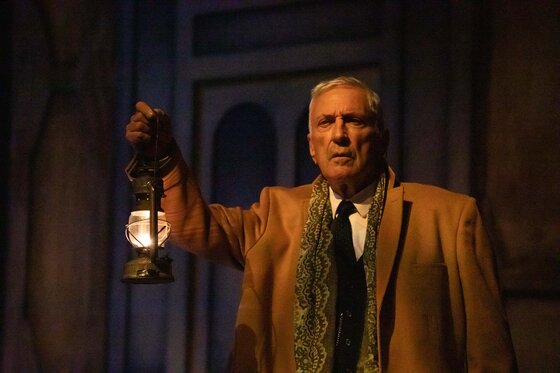The second longest running play (excluding musicals) in London’s West End, The Woman in Black is no neatly packaged fairy story. It is a dark tale of despair and revenge. It concerns a man driven to tell his truth after the death of an elderly and reclusive widow, Mrs Alice Drablow. I speak of Arthur Kipps (John Waters), who is desperate to unburden himself.

He wants to tell his tale of woe, but has no elocution skills and engages an actor (Daniel MacPherson) to help him with that. So it is that the actor plays young Kipps, while Kipps fills the role of all the other characters, as well as narrating the play. As a lawyer, young Kipps travels to a fictious village on the northeast coast of England, known as Crythin Gifford – marsh country – to sort out Mrs Drablow’s affairs.
With so many private papers to go through, the task proves onerous, but that’s not the half of it. While attending Mrs Drablow’s funeral the young Kipps first sets eyes on the ghostly figure of a woman in black. It is one that he will continue to encounter. And itr will haunt him as he travels to the now dead widow’s home, known as Eel Marsh House.

Assistance is in short supply, even though young Kipps could really do with it. It becomes clear that locals don’t want anything to do with Eel Marsh House. While carrying out his duty in isolation, with only a dog as a companion, young Kipps hears strange sounds and again confronts the apparition. It is left to him to try to figure out just what is going on and why the locals are so spooked. It will lead him to uncover a shocking tale of death and anguish that dates back nearly 60 years.
Adapted for the stage by Stephen Mallatratt from a 1983 book by Susan Hill, if a single word can sum up this ghost story, it is atmospheric. Of course, the acting is of critical importance, but there are few theatrical pieces in which sound and lighting are more to the fore. Both are achieved with distinction. Shadows add to the foreboding mood. In terms of sound, I am not just talking about things that go bump in the night, although there are certainly those, but also natural street noise and more. The blend works particularly well, aided by austere but redolent staging and props.

Turning to the script, it is what I would call a slow burn. The buildup, namely establishing just how Mr Kipps’ chilling tale will be told, takes time. The piece ignites once we get to the paranormal. The scares take the form of a sudden loud sound, the appearance of the apparition, screams and squeals. The Woman in Black really comes into its own in Act II, as the narrative is developed and the true horror in the storytelling is revealed.
The two established stars, John Waters and Daniel MacPherson, are first rate. They milk the material for all it is worth, not missing a beat. It is most amusing to watch Waters as an elderly Arthur Kipps trying to deliver lines without any life in them at the get go. Then contrast that with the fine job he does inhabiting several characters as the production unfolds. MacPherson is forever the enthusiast, the driving force … who quickly gets stuck into his role and then lets it run. The haunting nature of The Woman in Black is apparent throughout and gives it bite.

It is on at Athenaeum Theatre until 6th July 2024. It then moves to Canberra Theatre (9-14 July), Wollongong’s Illawara Performing Arts Centre (17-21 July), Newcastle’s Civic Theatre (23-27 July) and Theatre Royal Sydney (30 July-17 August).








